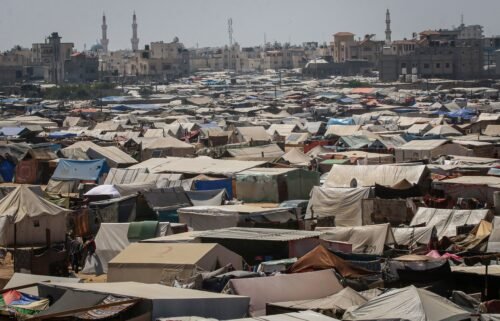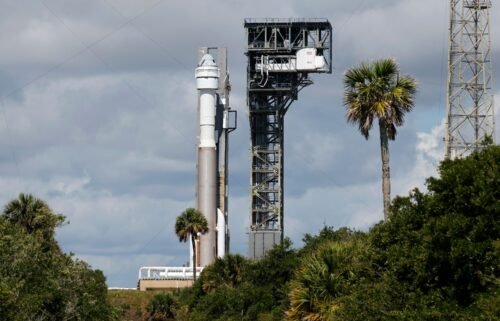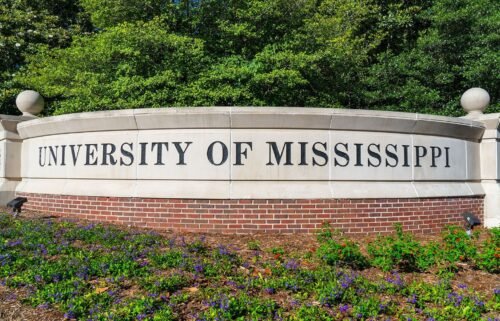As March Madness descends on Indianapolis, the city struggles with some of its highest homicide numbers ever

As Indianapolis hosts the NCAA Tournament this month, it does so against the backdrop of a rise in homicides that threaten to thwart this sprawling city’s economic recovery.
Sports events drive much of the tourism in Indiana, and typically bring in millions annually. But the Covid-19 pandemic has put a halt to this thriving industry, a factor some see as having contributed to the rise in homicides.
Ryan Vaughn, president of the Indiana Sports Corp, a non-profit dedicated to hosting sports events in the state, said that Indianapolis as a brand destination is the result of multiple administrations and civic leaders’ determined efforts.
Indianapolis’ first splash came in the 1980s when Indiana hosted the National Sports Festival and the Pan American Games. More recently, the city hosted the Super Bowl in 2012 and multiple Final Fours, partly due to the NCAA being headquartered in the city. Indeed, basketball, Vaughn said, is a big part of the culture in Indianapolis.
“I think every Hoosier feels like they own the sport of basketball,” he said. “Nine of the 10 largest high school gyms in the country for basketball are in Indiana. That fact alone probably speaks to our great passion for it.”
In normal times, the events that Indiana Sports Corp brings to the state generate $150 to 200 million a year, Vaughn said. March Madness alone is expected to have a more than $100 million economic impact, he said, similar to what one Final Four weekend has generated in the past.
This revenue doesn’t include the mainstays in Indianapolis — its NFL, NBA, or minor league teams — or the Indianapolis 500.
“The priority of the city is for us to the be the sports mecca, and we have invested millions and millions of dollars in becoming that and having that image,” said the Rev. Charles Harrison, a local pastor, and activist. “And in the meantime, when you look across the city, we have become in the last six years, one of the most violent cities in America.”
As of March 13, according to preliminary incident counts from the Indianapolis Metropolitan Police Department, there haven’t been any criminal homicides in Indianapolis’ downtown district, where most of the tournament games will be played and teams will be staying.
But the downtown area has had other challenges. When the Covid-19 pandemic hit, only 10% to 12% of the 150,000 to 175,000 people who typically work in the urban core went downtown, as offices went remote and businesses closed, according to Bob Schultz, senior vice president of events for Downtown Indy, Inc., a local non-profit.
Then this summer, about 100 downtown businesses were damaged during protests in the wake of George Floyd’s death at the hands of police, which deterred locals from spending time downtown, Schultz added.
Now ‘one of the most violent cities in America’
The night Nya Cope was killed, she, her mother, and a friend were on the road, driving to get late-night food on the east side of Indianapolis. As they found themselves caught in a crowd of young people who were gathering for a car show, the 16-year-old told her mother, Nikki Cope, not to worry.
Just moments later, gunshots were fired, and Nya was slumped over in the front passenger seat. A stray bullet had hit her in the head. First responders took her to the hospital, where she was pronounced dead after 1 a.m. on May 3, Cope says.
“I didn’t realize that (violence in the area) could be that bad because I wouldn’t have went,” said Cope, a resident of Marion, Indiana, more than an hour north of where Nya was killed.
Nya is just one of the 214 people to die by criminal homicide in Indianapolis in 2020 — a nearly 40% increase from the year prior and the city’s highest annual tally on record, according to the Indianapolis Metropolitan Police Department.
As of March 13, 2021, there have been 50 criminal homicides in Indianapolis, according to the IMPD’s preliminary incident counts — a nearly 43% increase compared to the same time period last year.
In January, more than two months after the NCAA announced that all of March Madness would take place in Indiana, five people and an unborn child were fatally shot — Indianapolis’ “largest mass casualty shooting in more than a decade,” Police Chief Randal Taylor said at the time. Less than a week before the first tipoff, four people, including a 7-year-old, were shot dead after an argument over a stimulus check, according to court documents. Arrests were made in both cases.
Josh Barker, IMPD’s deputy chief of operations, said many of the areas in the city that have seen a rise in homicides and aggravated assaults have typically been disproportionately affected in the past. But the problem has become more widespread, too, he said.
“There’s much more of a splatter pattern (on the crime map),” Barker said. “We’re seeing those types of crimes occurring really all over the city, which is making it more difficult to refine, reassess and redirect resources.”
Indianapolis isn’t alone in its increasing number of homicides. In metropolitan areas throughout the country, homicides increased by nearly 33%, according to data provided by the Major Cities Chiefs Association, a professional organization of police executives representing the largest cities in the US.
“I think there are multiple variables, especially in 2020,” said Laura Cooper, the group’s executive director, citing Covid-19, protests, a backlog in the court system due to the pandemic, criminal justice reform policies as well as proliferation and ease of access to get firearms.
Addressing the rise in violence
As with the rise in violence on the national level, city and neighborhood leaders alike say there is a multitude of factors contributing to the rise in homicides in Indianapolis.
The Rev. Harrison — who started a non-profit more than a decade ago called Indy Ten Point Coalition, which aims to help those affected by violence in Indianapolis neighborhoods — says his organization sees three common themes: drug trafficking, robberies and personal grievances.
“Years ago, individuals would fight and resolve their conflicts or talk it out. Today they’re not doing that — they’re using guns and knives to settle their conflicts, and we’re seeing a lot of interpersonal shootings and conflicts.”
Five nights a week, 30 to 50 volunteers with Harrison’s organization go into the neighborhoods and work with individuals in the community to provide counsel and resources to people in these areas, particularly males aged 14 to 24, who he said are disproportionately affected by violence.
“When you have the same people out there night after night, you’re able to really build those relationships, and you have the institutional knowledge about the neighborhood, and that has really been effective for us,” he said.
Shonna Majors, director of violence reduction for the Indianapolis public safety office, said she thinks the pandemic has played a role in the amount of violence in the city.
“A lot of our returning citizens and lower-income residents really count on the hospitality industry for work and having downtown pretty much shut down and close, and that’s changing their economic situations at home,” she said.
Majors said reducing gun violence is a key part of the city’s efforts to decrease homicides.
That’s something Nya’s mother, Nikki Cope, said she hopes leaders can find a way to manage.
“My whole life was her, every day, just work and her,” Cope said of her daughter. “But now she’s yanked from me because of someone’s irresponsible behavior.”



